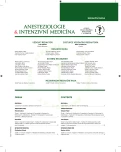Consciousness as a cosmic phenomenon
Authors:
B. Sániová; M. Drobný
Authors‘ workplace:
Klinika anestéziológie a intenzívnej medicíny, Jeseniova lekárska fakulta UK a Univerzitná nemocnica Martin, Slovenská republika
Published in:
Anest. intenziv. Med., 27, 2016, č. 1, s. 25-31
Category:
Intesive Care Medicine - Special Article
*Prehľad základných myšlienok, ktoré rezonovali na 21. výročnej medzinárodnej interdisciplinárnej konferencii 9.–13. júna 2015 v Helsinkách, ktorá sa konala pod názvom Toward a Science of Consciousness 2015 (TSC 2015).
Overview
More than 600 participants took part in the 21st Toward a Science of Consciousness (TSC) international interdisciplinary conference in Helsinki in 2015, which was focused on the basic issues associated with conscious experience. The aim of such conferences is to bring together neuroscientists, neurologists, anaesthesiologists, philosophers, contemplative and experiential metaphysics opinion leaders, to explore this difficult topic from all possible aspects, in depth and on the basis of sound knowledge.
The nature and mechanisms of human consciousness are emerging as one of the most important scientific and philosophical questions of the 21st century. Dualism is the most plausible concept explaining the emergence of consciousness after the Big Bang when antimatter changed to the current matter. In this cosmological time the quantum entanglement was installed, which today‘s dualism considers as the first developmental phase of consciousness. The wave function of electromagnetism plays an important role in the phase of human conscious awareness, but also in the lower stages. This function is generated primarily in the intracellular microtubule digital machines, but then it is passed through the microtubule plasma inter-phase, which converts the digital wave into an analogue waveform. The analogue electromagnetic waveform is then processed in electrical synapses (gap junctions), which generate the fundamental quantitative characteristics of human consciousness – lucidity and vigilance. The quantum theory of Penrose-Hameroff offers a plausible neuro-biological, classic-computing and quantum-computing interpretation of this function. Since the change and loss of consciousness are essential components of general anaesthesia, the greatest medical discovery of this millennium may be the nature of human consciousness and its changes during general anaesthesia as well as the mechanisms of information transmission between the mind and the soul – qualia.
Keywords:
neuroscience – human consciousness – quantum entanglement – microtubules – electrical synapses – general anaesthesia
Sources
1. Sániová, B., Drobný, M., Drobná, E., Hamžík, J., Fischer E. Power spectral analysis of EEG signal in Fp1-A1 grid during full consciousness and general anaesthesia with inhalation anaesthetic gas (Sevorane and Desflurane). In: Toward a Science of Consciousness. Book of abstracts, 9–13 June, Helsinki, Finland. 2015, p. 277.
2. Sherrington, C. Man on his nature. 2nd ed. Cambridge: Cambridge University Press, 1953, 247 p.
3. Chalmers, D. Consciousness and the collapse of the wave function. ANU seminar series Canberra Australia apr. 2015. In: Toward a Science of Consciousness, Book of abstracts, 9–13 June, Helsinki, Finland. 2015, p. 87–88.
4. Hameroff, S., Penrose, R. Consciousness in the universe: A review of the Orch OR theory. Physics of Life Reviews, 2014, 11, 1, p. 39–78.
5. Hameroff, S. R. The quantum pleasure principle’ and ‘Orch OR’ – How life and the brain evolved to feel good. In: Tibayrenc, M., Ayala, F. On Human Nature. Elsevier, 2015 in preparation.
6. Diósi, L. Models for universal reduction of macroscopic quantum fluctuations. Phys. Rev. A, 1989, 40, p. 1165.
7. Penrose, R. Wavefunction collapse as a real gravitational e_ect. In: Fokas, A., Kibble, T. W. B., Grigouriou, A., Zegarlinski, B. Mathematical Physics 2000, London: Imperial College Press. pp. 266–282.
8. Penrose, R. The Emperor‘s new mind: Concerning computers, minds and the laws of physics. The first edition, Oxford University Press, 1989, 480p. ISBN 0-19-851973-7.
9. Penrose, R., Hameroff, S. R. What gaps? Reply to Grush and Churchland. J. Conscious. Stud., 1995, 2, p. 99–112.
10. Hameroff, S. R., Penrose R. Conscious events as orchestrated space-time selections. J. Conscious. Stud., 1996, 3,1, p. 36–53.
11. Crick, F., Koch, C. Cortical areas in visual awareness – Reply. Nature, 1995, 377, p. 294–295.
12. Milner, A. D., Goodale, M. A. The visual brain in action. Oxford University Press, Oxford, 1995, 48p. ISBN: 0198524080.
13. Brown, E. N., Lydic, R., Schiff, N. D. General Anesthesia, Sleep, and Coma. N. Engl. J. Med., 2010, 30, 363, p. 2638–2650.
14. Kandel, E. R. The Age of Insight: The Quest to Understand the Unconscious in Art, Mind, and Brain, from Vienna 1900 to the Present. New York: Random House, 2012, 656p. ISBN 978-1400068715.
15. Emerson, D. J. et al. Direct modulation of microtubule stability contributes to anthracene general anesthesia. J. Am. Chem. Soc., 2013, 135,14, p. 5389–5398.
16. Hameroff, S. R. The Entwined mysteries of anesthesia and consciousness. Is there a common underlying mechanism? Anesthesiology, 2006, 105, 2, p. 400–412.
17. Craddock, J. A., Travi, R., Hameroff, S. T. Anesthetics act in quantum channels in brain microtubules to prevent consciousness. Current Topics in Medical Chemistry, 2015, 15, 6, p. 523–533.
Labels
Anaesthesiology, Resuscitation and Inten Intensive Care MedicineArticle was published in
Anaesthesiology and Intensive Care Medicine

2016 Issue 1
Most read in this issue
- Metabolic consequences of bowel damage in intensive care
- Initial experience with adenosin-induced circulatory arrest during cerebral artery aneurysm surgery – first experience
- Consciousness as a cosmic phenomenon
- Evaluation of Patients With Suspected Acute Pulmonary Embolism: Best Practice Advice From the Clinical Guidelines Committee of the American College of Physicians
